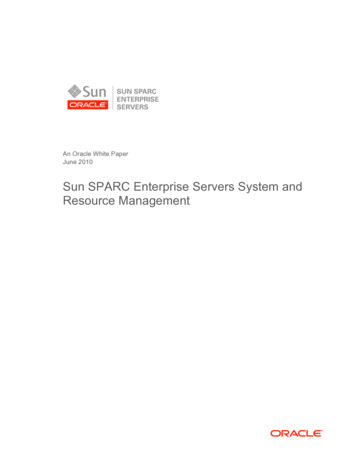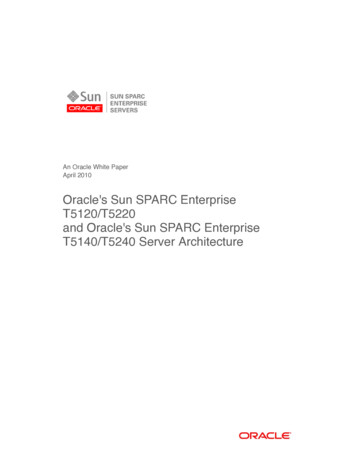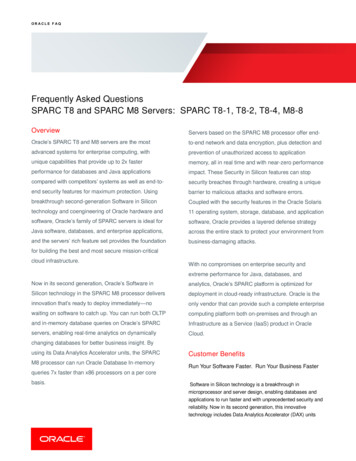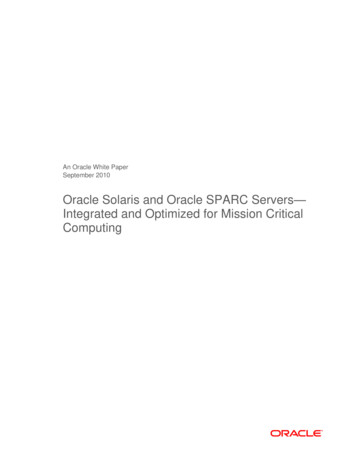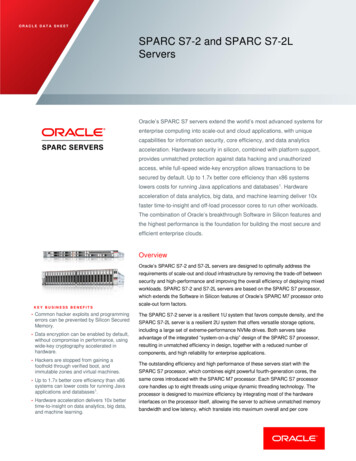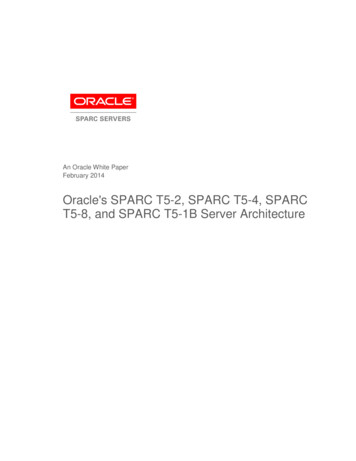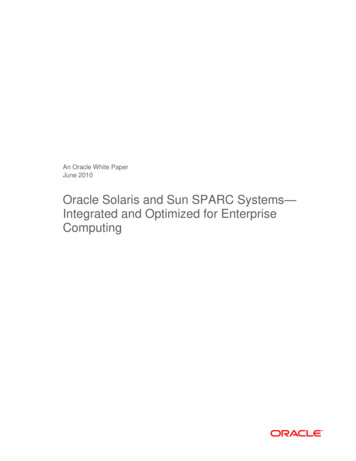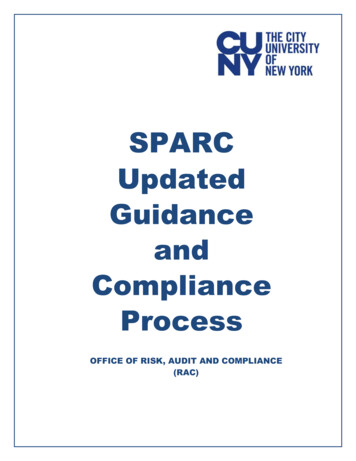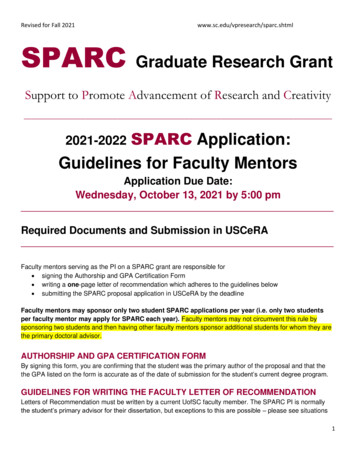
Transcription
Oracle’s SPARC T7 and SPARC M7 Server ArchitectureSoftware in Silicon: Enabling Secure Cloudsfor the Real-Time EnterpriseORACLE WHITE PAPER AUGUST 2016
Table of ContentsIntroduction1Comparison of Features3SPARC M7 Processor5SPARC M7 Processor Architecture6Processor Core and Cache Architecture7Software in Silicon Technology7Silicon Secured Memory8Encryption Acceleration10In-Memory Query Acceleration10In-Line Decompression11SPARC M7 Processor–Based Server Family Overview11Memory Subsystem12I/O Subsystem12I/O Controller ASIC13NVM Express Technology13Embedded USB Storage and Oracle Solaris Boot Pool13PCIe Adapter CardsSPARC T7-1, T7-2, and T7-4 Servers1414SPARC T7-1 Server15SPARC T7-2 Server16SPARC T7-4 Server19SPARC M7-8 and M7-16 ServersORACLE’S SPARC T7 AND SPARC M7 SERVER ARCHITECTURE21
Server Components21CPU, Memory, and I/O Unit Chassis21CPU, Memory, and I/O Unit Board22Interconnect Assembly24Switch Chassis and Switch Unit24Service Processor, Service Processor Proxy, and Service Processor Module25System Rack and Power Distribution Units25SPARC M7-8 Server25SPARC M7-8 Server with a Single Physical Domain26SPARC M7-8 Server with Two Physical Domains27SPARC M7-16 Server29Oracle Solaris32Virtualization34Systems Management36Oracle ILOM and Service Processor36Power Management37Oracle Enterprise Manager Ops Center37Reliability, Availability, and Serviceability38Advanced Reliability Features38Error Detection, Diagnosis, and Recovery39Redundant and Hot-Serviceable Components39Conclusion40For More Information41ORACLE’S SPARC T7 AND SPARC M7 SERVER ARCHITECTURE
IntroductionModern technology initiatives are driving IT infrastructure in a new direction. Big data, social business,mobile applications, cloud, and real-time analytics all require forward-thinking solutions and enoughcompute power to deliver the performance required in a rapidly evolving digital marketplace.Customers increasingly drive the speed of business, and organizations need to engage with customerson their terms. The need to manage sensitive information with high levels of security as well ascapture, analyze, and act upon massive volumes of data every hour of every day has become critical.These challenges will dramatically change the way that IT systems are designed, funded, and runcompared to the past few decades. Data security can no longer be treated as an afterthought, becausebillions of dollars are lost each year to computer intrusions. The massive explosion in data volume,variety, and velocity increases the need for secure and effective analytics so that organizations canmake better and quicker decisions. Complex IT infrastructure poses an impediment by becoming moredifficult and expensive to maintain at precisely the moment that organizations are under pressure todrive down costs, increase operating efficiencies, and deliver innovative technologies that cangenerate new revenue streams.1 ORACLE’S SPARC T7 AND SPARC M7 SERVER ARCHITECTURE
Oracle’s new SPARC M7 processor–based servers take Oracle’s server technology to new levels byoffering the world’s first implementation of Oracle’s Software in Silicon technology to build clouds withthe most secure platforms in the world. Offering both database and application security andacceleration, these servers offer silicon secured memory, In-Memory Query Acceleration, datacompression and decompression, and encryption at their core. The SPARC M7 processor alsoimproves density by doubling the core count of previous-generation processors to support 32 cores perprocessor, with an architecture that supports up to 256 threads in as little as 2U of space. The SPARCM7 processor also sports improved per-thread performance, reliability, availability, and serviceability(RAS) capabilities, power-efficiency, and double the memory and I/O bandwidths of previous SPARCprocessors. A new cache and memory hierarchy, along with other improvements, helps to provide upto triple the processing speed of earlier systems.Oracle’s SPARC M7 processor–based servers power the real-time enterprise with the most efficientplatforms in the world, allowing organizations to compete in today’s digital marketplace, save moneyand time, and boost their bottom line. At the same time, Oracle’s technology innovation creates valueand drives lower costs and higher ROI for any organization. Based on SPARC M7 processoradvances, the new SPARC server family from Oracle (Figure 1) provides new levels of performanceand throughput. Scaling from one to 16 SPARC M7 processors, the servers constitute a flexible andextensible product family with very high levels of integration to help improve security, lower costs, andincrease reliability. An optimized system design provides support for all enterprise services andapplication types. Uniformity of management interfaces and adoption of standards also help reduceadministrative costs, while innovative chassis design provides density, efficiency, and economy formodern data centers.SPARC T7-1 serverSPARC T7-2 server SPARC T7-4 server SPARC M7-8 serverFigure 1. Oracle’s SPARC M7 processor–based server product family.2 ORACLE’S SPARC T7 AND SPARC M7 SERVER ARCHITECTURESPARC M7-16 server
Comparison of FeaturesTable 1 provides a feature comparison of the SPARC T7-1, T7-2, T7-4, M7-8 and M7-16 servers.TABLE 1. SPARC M7 PROCESSOR–BASED SERVER FEATURES COMPARISON.FeatureForm factorSPARC T7-1SPARC T7-2SPARC T7-4SPARC M7-8SPARC M7-16ServerServerServerServerServer2U,737 mm / 29" deep3U,753 mm / 29.6" deep5U,835 mm / 32.9" deepSystem Rack:600 mm wide,1200 mm deep,2 m / 78.7" highStandalone:10U,813 mm / 32" deepSystem Rack:600 mm wide,1200 mm deep,2 m / 78.7" high1 or 2(Static)1 ,2, 3, or 4(Reconfigurable)Physical domains132-core 4.13 GHz SPARC M7 processor64 MB Level 3 cache, fully shared and partitioned, 8 MB per each core clusterUp to 256 threads per processorSilicon Secured MemoryProcessor32 DAX engines for In-Memory Query Acceleration and In-Line DecompressionEncryption instruction accelerators in each core with direct support for 15 industry-standard cryptographic algorithmsplus random number generation: AES, Camellia, CRC32c, DES, 3DES, DH, DSA, ECC, MD5, RSA, SHA-1,SHA-224, SHA-256, SHA-384, SHA-512Processor quantity122 or 42–84–16Maximum cores3264128256512Maximum threads2565121,0242,0484,09616 GB, 32 GB or 64 GB DDR4-2133 memory DIMMs, 8 or 16 DIMMs per processorMemoryDIMM sparing is a standard feature increasing system reliability and uptime.1Max 1,024 GBMax 2,048 GBMax 4,096 GBMax 8,192 GBMax 16,384 GBMin 128 GBMin 256 GBMin 256 GBMin 512 GBMin 1,024 GBInternal 2.5-inchdisk drive bays868NASAS support forinternal 2.5-inchdisk drive baysOne integrated SAS3HBA with RAID0/1/10/1E supportingup to eight 2.5-inchSAS hard-disk drives(HDDs) or solid-statedrives (SSDs)Two integrated SAS3HBAs with RAID0/1/10/1E supportingup to six (2 4) SASHDDs or SSDsTwo integrated SAS3HBAs with RAID0/1/10/1E supportingup to eight (4 4)SAS HDDs or SSDsNANVMe support forinternal 2.5-inchdisk drive baysOne optional factoryconfigured PCIeswitch supporting upto four 2.5-inch NVMeSSDsOne or two optionalfactory-configuredPCIe switchessupporting up to four2.5-inch NVMe SSDsTwo optional PCIeswitches supportingup to eight (4 4)2.5-inch NVMe SSDsNAMemory capacity11.Raw memory capacities. DIMM sparing is enabled with fully populated memory and reserves one sixteenth of memory capacity. DIMMsparing enables automatic retirement of an entire DIMM without interrupting system operation, causing loss of memory capacity, orchanging error protection capability.3 ORACLE’S SPARC T7 AND SPARC M7 SERVER ARCHITECTURE
TABLE 1. SPARC M7 PROCESSOR–BASED SERVER FEATURES COMPARISON (CONTINUED).FeatureSPARC T7-1SPARC T7-2SPARC T7-4SPARC M7-8SPARC M7-16ServerServerServerServerServer6681632DVD R/-WDVD R/-WMaximum numberof Oracle FlashAccelerator F160PCIe Cards (NVMe)Removable mediaNo DVD (accessed via USB and rKVMS)Two Ethernet 1000BASE-T ports3(active/standby)2One Ethernet 100BASE-T portManagement portsOne serial RJ45 portOne HD-15 VGAvideo portVideo portsTwo HD-15 VGA video portsTwo USB 2.0 (front) andtwo USB 3.0 (rear) portsUSB portsTwo serial RJ45 ports (active/standby)Four USB 3.0 portsFour integrated 10GBASE-T ports4Ethernet16 hot-pluggableslotsUp to 24hot-pluggable slotsUp to 48hot-pluggable slotsEight x8 and eightx16 slotsThree x16 slots perprocessorThree x16 slots perprocessorSupported by 12PCIe root complexesOne PCIe rootcomplex per slotOne PCIe rootcomplex per slot1020Up to 32Up to 642 redundanthot-swappable AC1000 W powersupplies2 redundanthot-swappable AC2000 W powersupplies4 hot-swappable AC3000 W powersupplies6 hot-swappable AC3000 W powersupplies16 hot-swappable AC3000 W powersupplies4 dual-fan modules,top loading6 fans, top loading5 dual-fan modules,rear loading8 dual-fan modules,front loading52 dual-fan modules,front and rear loading6 slots8 slotsSix x8 slots, or twox16 and two x8 slotsFour x8 and four x16slotsSupported by 4 PCIeroot complexesSupported by 8 PCIeroot complexesTotal PCIe rootcomplexes5N N redundantpower suppliesN 1 redundanthot-swappable fansNAVia PCIe adapters cardsTwo integrated Ethernet controllersPCIe 3.0low-profile slotsNAOracle recommends Oracle Solaris 11.3 or later for enhanced performance and functionality, including featuresenabled by Software in Silicon technologyControl, root, and I/O domains:» Oracle Solaris 11.3 or later5The following versions are supported within guest domains:Operating system»»»»Oracle Solaris 11.3 or later5Oracle Solaris 10 1/136Oracle Solaris 10 8/116Oracle Solaris 10 9/106Applications certified for Oracle Solaris 8 or Oracle Solaris 9 only may run in an Oracle Solaris 8 or Oracle Solaris 9Branded Zone running within an Oracle Solaris 10 guest domain.2.100BASE-T auto negotiates to 10 Mb/sec and 100 Mb/sec, full- or half-duplex.3.1000BASE-T auto negotiates to 10 Mb/sec, 100 Mb /sec, and 1 Gb/sec, full-duplex only.4.10GBASE-T auto negotiates to 100 Mb/sec, 1 Gb/sec, and 10 Gb/sec, full-duplex only. Jumbo frames are supported, up to 15,500 bytes.5.Versions of Oracle Solaris 11 prior to 11.3 are not supported on SPARC M7 processor–based servers.6.Plus required patches.4 ORACLE’S SPARC T7 AND SPARC M7 SERVER ARCHITECTURE
SPARC M7 ProcessorWith its new Software in Silicon capabilities coupled with an innovative cache and memory hierarchy, Oracle’sSPARC M7 processor delivers dramatically higher processing speed and revolutionary protection against malwareand software errors.The Silicon Secured Memory feature of the SPARC M7 processor (Figure 2) provides real-time data integritychecking to guard against pointer-related software errors and malware. It replaces very costly softwareinstrumentation with low-overhead hardware monitoring. Silicon Secured Memory enables applications to identifyerroneous or unauthorized memory access, diagnose the cause, and take appropriate recovery actions. TheSPARC M7 processor has crypto instruction accelerators integrated directly into each processor core. Theseaccelerators enable high-speed encryption for over a dozen industry-standard ciphers, eliminating the performanceand cost barriers typically associated with secure computing.The SPARC M7 processor also incorporates hardware units that accelerate specific software functions or primitives.The on-chip Data Analytics Accelerators (DAX) offload database query processing and perform real-time datadecompression. The In-Memory Query Acceleration delivers performance that is up to ten times faster compared toother processors. The In-Line Decompression feature allows up to two times more data to be stored in the samememory footprint, without any performance penalty.Figure 2. The SPARC M7 processor combines 32 cores along with Software in Silicon features to accelerate application anddatabase performance.The per-thread performance is improved with the entirely new on-chip L2 and L3 cache design and increasedprocessor frequency. The 64 MB L3 cache is partitioned and fully shared, and hot cache lines are migrated to theclosest partition to minimize latency and maximize performance. The architecture of the core clusters and partitionedcache is ideal for server virtualization and pluggable databases. System administration and performance tuning areeasier, because the design minimizes interaction between logical domains or between databases. The processorcan dynamically trade per-thread performance for throughput by running up to 256 threads, or it can run fewerhigher-performance threads by devoting more resources to each thread. This flexibility allows the system to balanceoverall throughput versus per-thread performance for optimal results.5 ORACLE’S SPARC T7 AND SPARC M7 SERVER ARCHITECTURE
The 32-core SPARC M7 processor is binary-compatible with earlier SPARC processors and provides 256 hardwarethreads—more than any multicore processor previously available. It is ideal for virtualized cloud computingenvironments, supporting a large number of virtual machines and delivering excellent multithreaded performance.This processor enables organizations to rapidly scale the delivery of new network services with maximum efficiencyand predictability.Table 2 provides a comparison between Oracle’s SPARC M7, SPARC M6, and SPARC T5 processors.TABLE 2. SPARC M7, SPARC M6, AND SPARC T5 PROCESSOR FEATURE COMPARISON.FeatureSPARC M7 ProcessorCPU frequencySPARC M6 ProcessorSPARC T5 Processor4.13 GHz3.6 GHz3.6 GHzOut-of-order executionYesYesYesDual-instruction issueYesYesYesData/instruction prefetchYesYesYes4th generation3rd generation3rd generationCores per processor321216Threads per core88825696128Up to 16Up to 32Up to 8Up to 16 DDR4 DIMMsUp to 32 DDR3 DIMMsUp to 16 DDR3 DIMMs16 KB L1 four-way instructioncache16 KB L1 four-way instructioncacheShared 256 KB L2 four-wayinstruction cache (per quadcores)16 KB L1 four-way data cache16 KB L1 four-way data cache128 KB L2 eight-way cache128 KB L2 eight-way cacheShared 256 KB L2 eight-waydata cache (per core pair)Shared 48 MB L3 twelve-waycacheShared 8 MB L3 sixteen-waycache16 GB2 GB2 GB¼ of chipEntire chipEntire chip20 nm technology28 nm technology28 nm technologySPARC Core typeThreads per processorSockets in systemsMemory per processor16 KB L1 four-way instructioncache16 KB L1 four-way data cacheCachesShared 64 MB (L3) cacheLarge page support1Power management granularityTechnology1. Large page support with Oracle Solaris 11.3SPARC M7 Processor ArchitectureIn order to deliver commercial workloads with appropriate levels of throughput, the SPARC M7 processorimplements a new cache and memory hierarchy coupled with other improvements that can provide up to triple theprocessing speed of previous-generation processors. Power management improvements are also key to theincreased in-system performance, and dynamic voltage frequency scaling (DVFS) is provided.Figure 3 illustrates the architecture of the SPARC M7 processor. The processor contains 32 SPARC cores that aregrouped into eight core clusters. Four memory controller units (MCUs) are provided, with each connecting to thebuffer-on-board (BoB) ASICs via high-speed links. The BoB has two DDR4 channels with each connecting to asingle memory DIMM. A total of up to 16 DDR4 DIMMs is supported per SPARC M7 processor. Two coprocessorsare associated with each MCU and provide Software in Silicon functionality.6 ORACLE’S SPARC T7 AND SPARC M7 SERVER ARCHITECTURE
There are two Coherency Link Clusters (CLCs) that provide eight Coherency and Scalability Links (CL/SL) forconnectivity and coherency with other SPARC M7 processors. Two I/O Links (IL) connect to the I/O controller ASICsin the SPARC M7 processor–based servers. Up to eight SPARC M7 processors can be connected in a singleglueless symmetrical multiprocessing (SMP) system without additional logic. Larger systems are built usingOracle-designed switch ASICs that provide coherency switching.A high-bandwidth, low-latency on-chip network (OCN) connects the eight L3 cache partitions to each other, to thefour MCUs, and to the I/O and coherence gateways, each of which handles distinct sets of addresses. The OCNmaintains coherency both on-chip and off-chip.Figure 3. The SPARC M7 processor features 32 cores, eight SPARC core clusters, four memory controller units (MCUs), and eightData Analytics Accelerators (DAXs).Processor Core and Cache ArchitectureIn the SPARC M7 processor the core is dual-issue, out-of-order, and supports up to eight hardware threads. Thecore provides Dynamic Threading to optimize for the highest possible per-thread performance. Software canactivate up to eight hardware threads (strands) on each core via Critical Threads Optimization. The processorhardware then dynamically and seamlessly allocates core resources among the active strands.The memory management unit (MMU) in the core provides a hardware table walk (HWTW) and supports 8 KB, 64KB, 4 MB, 256 MB, 2 GB, and 16 GB pages.Four SPARC cores are combined into a SPARC core cluster with eight SPARC core clusters per SPARC M7processor. Within the SPARC core cluster, each core has its own 16 KB L1 instruction and data cache. Two coresthen share a 256 KB L2 data cache with the four cores sharing a 256 KB L2 instruction cache. The L3 cache is fullyshared and partitioned. The L3 partition is eight-way set-associative with a 64-byte line size, and is composed of twoaddress-interleaved banks. Any L3 partition may serve a request from any of the 32 cores of the SPARC M7processor. Hot cache lines are migrated to the closest L3 cache partition to optimize for performance.Software in Silicon TechnologyMost processor chip development focuses on better and faster general-purpose processing. Several years agoOracle initiated a revolutionary project to move in-memory database functions directly onto the chip, with hard-wiredprotection for data in memory. By innovating at the processor, system, and application levels, Oracle is in a unique7 ORACLE’S SPARC T7 AND SPARC M7 SERVER ARCHITECTURE
position to optimize application performance through this approach. The SPARC M7 processor capitalizes on thisability by providing Software in Silicon functionality integrated into the SPARC M7 processor itself.The SPARC M7 processor incorporates on-chip accelerators to off-load in-memory database query processing andperform real-time data decompression, while crypto instruction accelerators are integrated directly into eachprocessor core. Together, the Software in Silicon features deliver significant advantages for security, performanceand efficiency, including the following:Security in Silicon» Silicon Secured Memory provides real-time data integrity checking to guard against pointer-related softwareerrors and malware, replacing very costly software instrumentation with low-overhead hardware monitoring.Silicon Secured Memory enables applications to identify erroneous or unauthorized memory access, diagnose thecause, and take appropriate recovery actions.» Accelerated cryptography helps eliminate the performance and cost barriers typically associated with securecomputing—which is increasingly essential for modern business operation.SQL in Silicon» In-memory query acceleration provided by DAX delivers performance that is up to ten times faster compared toother processors.» The In-Line Decompression feature enables storing up to two times more data in the same memory footprint,without a performance penalty.In addition to the crypto instruction accelerators that are included in every core the SPARC M7 processor containseight DAXs, each with four pipelines, or engines. These engines can process 32 independent data streams,offloading the processor cores to do other work. The DAX engines can process query functions such asdecompress, scan, filter and join.The DAXs use very low-overhead interprocess communication and extremely fast atomic operations. For example,DAXs located on different processors can exchange messages and access remote memory locations, exchanginglocks without CPU involvement. Utilizing this functionality requires Oracle Database 12c with the In-Memory optionand Oracle Solaris 11.3 or later. The sections that follow describe Software in Silicon features enabled by the onchip accelerators.Existing applications can be enabled with Silicon Secured Memory, without recompiling, by linking with the correctOracle Solaris libraries and being verified in a test environment. Open Oracle Solaris APIs are available for softwaredevelopers to leverage Silicon Secured Memory and DAX technologies.Silicon Secured MemorySilicon Secured Memory in the SPARC M7 processor provides the first-ever hardware-based memory protection byplacing dynamic pointer checking in hardware. Silicon Secured Memory detects and reports memory referenceerrors and stops unintentional or malicious accesses to the data in memory.Some programming languages such as C and C remain vulnerable to memory corruption caused by softwareerrors. These kinds of memory reference bugs are extremely hard to find, and victims usually notice corrupted dataonly long after the corruption has taken place. Complicating matters, databases and applications can have tens ofmillions of lines of code and thousands of developers. Importantly, errors such as buffer overflows are a majorsource of security exploits that can put an organization at risk.Modern applications use many threads working on large shared-memory segments. Bugs or pointer problems inthese applications can cause highly unpredictable behavior and consume excessive amounts of an applicationdeveloper’s time to troubleshoot and diagnose. Silent data corruption and buffer overruns are two of thesedifficult-to-diagnose problems. For both problems, Silicon Secured Memory in the SPARC M7 processor8 ORACLE’S SPARC T7 AND SPARC M7 SERVER ARCHITECTURE
dramatically reduces the time it takes for application developers to troubleshoot memory reference bugs. For silentdata corruption, Silicon Secured Memory can facilitate immediate action to be taken by the application, preventingcostly recovery efforts.Figure 4 illustrates the problem of silent data corruption where two application threads (A and B) accidentally accessthe same memory location. The color coding demarcates the memory areas that each thread should be accessing,respectively. However, a software programming error can mean that Thread A erroneously writes into thered-outlined area of Thread B. This error is typically not caught immediately, and is potentially detected only whenthat memory is read by Thread B. Thread B now has data that has been silently corrupted by Thread A, and thesource of the corruption is often extremely difficult to trace. This problem is extremely hard to diagnose, and typicallyis manifest as a software bug with potentially serious consequences.Figure 4. Silent data corruption occurs when two threads mistakenly write to the same memory location.Buffer overruns are an additional problem that can occur in application development. Simply stated, buffer overrunsimply that an application has erroneously started writing data beyond its allocated area (Figure 5). Through thiserror, sensitive data could be leaked into other memory locations and the application would not be aware of it. Anapplication with malicious intent could then legitimately read all this sensitive information. Buffer overruns canpresent a catastrophic security nightmare, often seen in today’s world in the form of malicious virus attacks.Figure 5. Buffer overruns can represent a significant security risk.Silicon Secured Memory in the SPARC M7 processor combats these problems by using a key for each (memory)pointer to serve as the memory version. During the process of memory allocation, a corresponding code is writteninto the memory as its version. When this memory is accessed by any pointer, the key and code are compared bythe hardware. If they match, the access is legal. If they do not match, there is a memory reference error, which iscaught immediately.9 ORACLE’S SPARC T7 AND SPARC M7 SERVER ARCHITECTURE
Encryption AccelerationEnhanced security has never been more important, and SPARC processors and systems have a long history ofproviding processor–based cryptographic acceleration. Each of the 32 cores in the SPARC M7 processor includes acrypto instruction accelerator with direct support for 15 industry-standard cryptographic algorithms plus randomnumber generation. Accelerated cryptography is supported through the Cryptographic Framework in Oracle Solaris.The SPARC M7 processor permits access to cryptographic cypher hardware implementations with supportedalgorithms that include AES, Camellia, CRC32c, DES, 3DES, DH, DSA, ECC, MD5, RSA, SHA-1, SHA-224,SHA-256, SHA-384, and SHA-512. The cyphers are implemented within the appropriate pipeline itself rather than asa coprocessor. This approach yields a more efficient implementation of the hardware-based cyphers as well as noprivilege-level changes, resulting in a large increase in efficiency in cryptographic algorithm calculations. In addition,database operations can make much more efficient use of the various cryptographic cyphers that are implementedwithin the instruction pipeline itself. Using the built-in encryption on the SPARC M7 processor across all layers of theOracle stack provides greater data security with almost no loss in performance.In-Memory Query AccelerationIn-memory query acceleration was designed to work with Oracle Database In-Memory, which was architected withfast analytics response as its primary design tenet. The traditional way of storing and accessing data in a databaseemploys a row format. This approach works well for transactional workloads that are subject to frequent inserts andupdates as well as for reporting style queries. However, analytics run best on a columnar format. With OracleDatabase In-Memory, it is possible to have a dual-format architecture that provides both row format for OLTPoperations and column format for analytic operations.1Oracle Database In-Memory populates the data in an in-memory column store. A set of compression algorithms isautomatically run on the data being stored in the in-memory column, providing storage economies. Moreover, whena query is run, it scans and filters data in its compressed format, eliminating the need to decompress the data. Thein-memory column store creates In-Memory Compression Units (IMCUs), as shown in Figure 6. The in-memorycolumnar data is fragmented into these smaller IMCUs so that parallelization is possible when running a query onthe overall data.Figure 6. In-memory columnar data is fragmented into smaller IMCUs to enable parallelization.1 In-Memory Query Acceleration is supported on SPARC T7 and M7 servers with these prerequisites: Oracle Solaris 11.3 or later and Oracle Database12c 12.1.0.2 Bundle Patch and In-Memory option.10 ORACLE’S SPARC T7 AND SPARC M7 SERVER ARCHITECTURE
When a core in the SPARC M7 processor receives a database query, it can be offloaded to the on-chip accelerator.Accelerated database operations include the following:» Select: Filter to reduce a column» Scan: Search (“where” clause)» Extract: Decompression» Translate: Lookup to accelerate big-to-small joinsAfter the query is offloaded, the core is free to resume other jobs such as higher-level SQL functions. Meanwhile,the accelerator runs the query and places the result in the L3 cache for fast access by the core. Once the relevantcore is informed of the completion of the query, it picks up the result.Beyond accelerating operations, the other advantage of this query offload mechanism is the massive parallelizationthat is facilitated by the 32 accelerator engines within each SPARC M7 processor. Each of the 32 cores in theprocessor has access to all of these accelerator engines and can use them simultaneously to run a single query in acompletely parallel fashion. The mechanics of this parallelism are achieved by the processor, and do not require theapplication code or the database to perform any extra operations. The accelerator can take data streams directlyfrom the memory subsystem through the SPARC M7 processor’s extremely high-bandwidth interfaces. As a result,queries can be performed on in-memory data at speeds determined by the memory interface, rather than beingcontrolled by the cache architecture that connects to the processor cores.In-Line DecompressionCompression is absolutely key to placing more data in memory and in storage. The speed of decompression is mostimportant for database applications, where reading typically outweighs writing. Unfortunately, although theperformance of decompression on today’s processors is adequate for disk access, it is slow for flash memory, andpresents an enormous bottleneck for in-memory database applications.To address this challenge, In-Line Decompression is implemented in the SPARC M7 processor’s DAX as an integralstep of the query process. The accelerator decompresses data and runs the query function in a single step, thuseliminating multiple reads and writes. The result is no-penalty, In-Line Decompression that can run at memoryspeeds—greater than 120 GB/second. The decompression sequence involves the following steps:» The processor core offloads query work to the accelerator, which reads the full compressed data (OZIPcompression is used).» The accelerator decompresses data on the fly and evaluates the query in a single step without any additional reador write operations.» The processor core then writes out the final result as uncompressed data.SPARC M7 Processor–Based Server Family OverviewThe SPARC M7 processor-based servers are designed for cloud infrastructures that required high levels of security,performance, and efficiency. These SPARC servers are ideal for database, Java, middleware, and enterpriseapplications, offering exceptional throughput performance and memory bandwidth. The server product familyprovides supp
Applications certified for Oracle Solaris 8 or Oracle Solaris 9 only may run in an Oracle Solaris 8 or Oracle Solaris 9 Branded Zone running within an Oracle Solaris 10 guest domain. 2. 100BASE-T auto negotiates to 10 Mb/sec and 100 Mb/sec, full- or half-duplex. 3. 1000BASE-T auto negotiates to 10 Mb/sec, 100 Mb /sec, and 1 Gb/sec, full-duplex .
